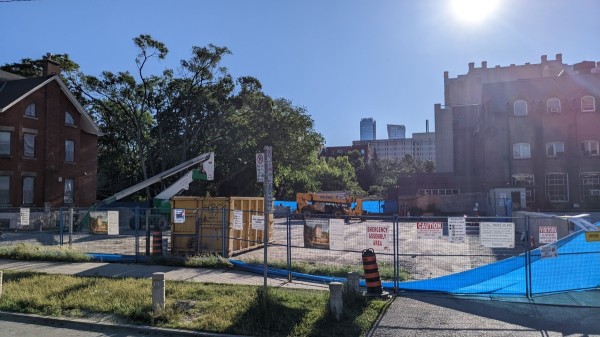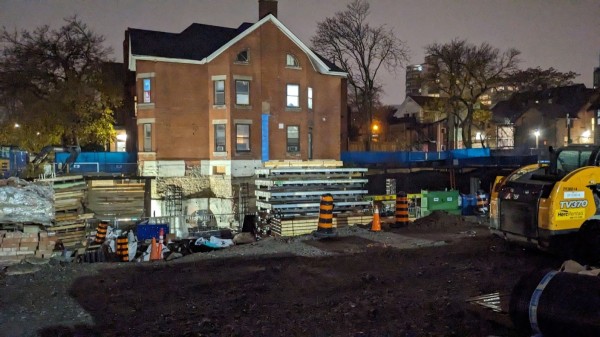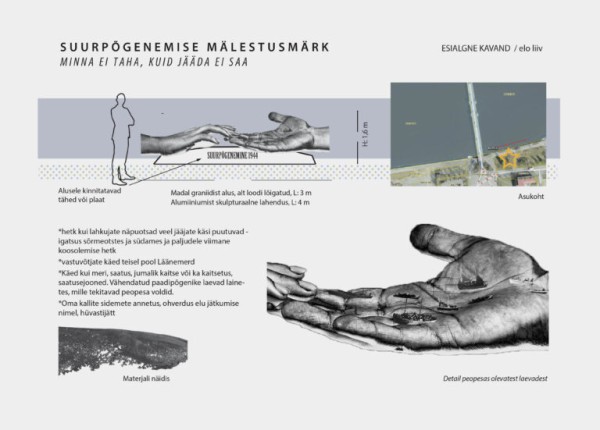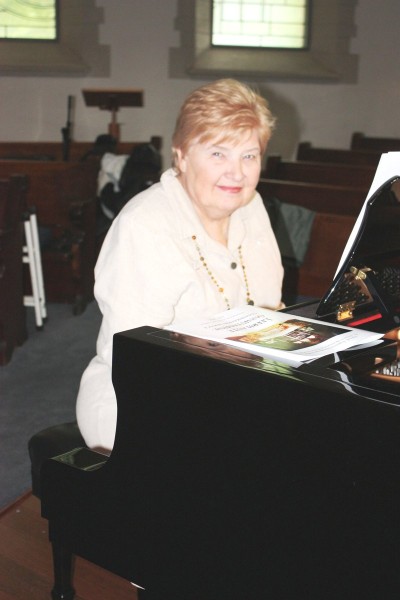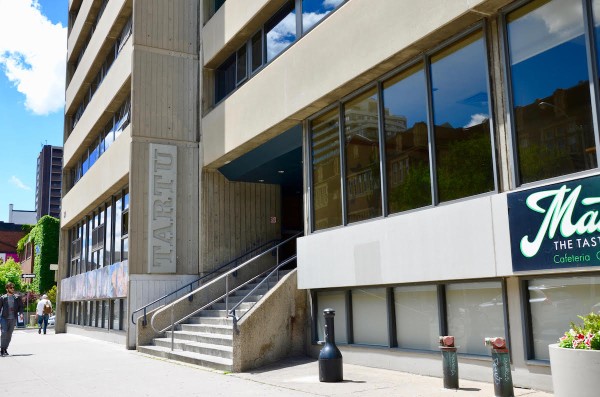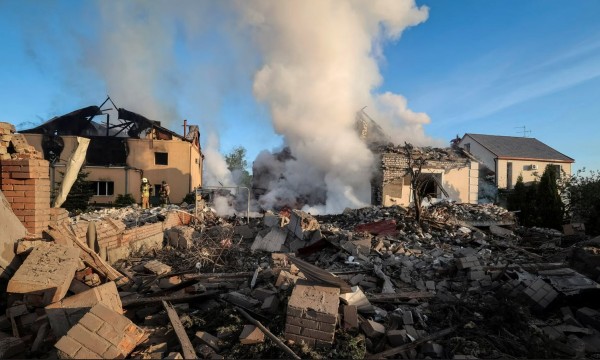In their latest update, the KESKUS group has announced that the Estonian community will have to move out of 958 Broadview Ave by October, 2022. The problem is that the new International Estonian Centre is nowhere near completion. In fact, construction at the 9 Madison Ave site had barely begun.
The original plan had included only one move, directly from 958 Broadview Ave to 9 Madison Ave. Unfortunately, this is not to be. After a 21 month leaseback period, the developer, Diamond Kilmer, is ready to move on. This will leave our community temporarily homeless. It also means that Estonian cultural groups will have to move twice. Once out of the current Eesti Maja to whatever place they can find, and second, from their new temporary home to the International Estonian Centre.
The recent update blames this predicament on “the COVID pandemic”, “slow and cumbersome municipal and TTC approvals”, “supply chain and construction challenges with tendering and trades”, and “financial pressures on EHTL itself”. Less charitably, it could be pointed out that this is one more broken promise by KESKUS, and that it has had a history of delays and overpromises. One could also ask if the fact that Diamond Kilmer recently settled with the City for only 14 stories (maximum 207 units, including 8 affordable home ownership units) will affect the final sales price of the 958 Broadview Ave property. But I am not going to do that here.
The purpose of this article is not to find fault with any individual or group. Instead, I want to point out that the possibility of the unfortunate chain of misfortunes we are experiencing was always inherent in the KESKUS project. By seeking to rebuild the Estonian House with a development partner (as was originally planned) or to sell it to a developer and build ourselves a new home, we exposed ourselves to the pitfalls facing all big projects.
This is why I had always felt that renovating the Eesti Maja piecemeal would have been much better plan. It is obviously too late now, but if begun, say, in 2008, it would have been do-able. The big advantage is that it would have been composed of many SMALL projects. Currently, we really have one BIG project. This implies many single points of failures and many choke points. This is the reason why so many large-scale military, government, and private projects are plagued with cost overruns and endless delays. Why would we expect KESKUS to be different?
In contrast, any delay or difficulty with one sub-project in the renovation approach, say a kitchen renovation, would only affect that sub-project. It would not affect the other sub-projects. Another advantage is that if some unforeseen event, like COVID, happens, it would have only adversely affect those projects incomplete at the time of lockdown. All the previous sub-projects would have been completed, and the ones not started could simply be delayed.
It has been claimed that the money for Eesti Maja’s renovation was not there. To see that this isn’t true, consider the fact that the KESKUS raised millions. If you can raise millions for a new building, then you can raise $50,000 for a new kitchen. We would also be able to exploit one the great strengths of our community – our volunteer tradition. Seedrioru, Kotkajärv and Jõekääru all have well-attended talgud to this day. Many of the projects comprising an Eesti Maja restoration could have been assigned to volunteer workers. If the Eesti Maja Sõbrad group had formed a decade earlier, think what they could have accomplished! Another source of funds is government grants. From what I have seen in politics, all levels of government like to shower multicultural groups with grant money. For proof, note that when the Estonian House finally applied for its first grant – to fix its badly leaking roof, it got it immediately.
The sequence of these projects could also be designed so that the upgrades of our rentable spaces would go first. With better and newer facilities, we would likely receive higher rents and have lower vacancy rates, than what we received for those halls after they had been purposely neglected for years.
Were there any untapped sources of operational income in the old Eesti Maja? I can think of two. First, we could have opened the parking lot every weekday morning for commuters. Even if we raised only $100 per day, that would raise an additional $26,000 per year. Another underutilized aspect of 958 Broadview was our street-front. I would have moved the pub from the basement to the front. After Whistler’s closed, it would have been the only pub/restaurant for many blocks. This would have been both a revenue generating venture and a cultural facility at the same time.
Oh well. The road not taken…
One move no longer an option for Estonian House tenants (13)
Eestlased Kanadas | 18 Jun 2022 | Markus AlliksaarEWR
Viimased kommentaarid
Kommentaarid on kirjutatud EWR lugejate poolt. Nende sisu ei pruugi ühtida EWR toimetuse seisukohtadega.
Our history is fake. Chester School is much older than what is claimed. They did not build stuff like that in our little pioneer village with horses and buggies. We can't even build that stuff today. Just little glass cubes.
Have a look at what Harbord Collegiate looked like before they rebuilt it. They show pictures on Google Images.
Research Tartaria.
Open your eyes.
https://www.bitchute.com/video...
Have a look at what Harbord Collegiate looked like before they rebuilt it. They show pictures on Google Images.
Research Tartaria.
Open your eyes.
https://www.bitchute.com/video...
Here is a tour, with many heritage plaques, of an era that overlaps with but differs from the sociohistorical era of Estonian House, and the Councillor is clear about Chester School as a nearby cultural heritage site:
https://www.toronto.ca/legdocs...
https://www.heritagetrust.on.c...
The Councillor cannot be faulted for not knowing what the “addition” was in the back of the Estonian House – or that the Estonian House was so much more than a “tomb” for Chester Public School! The Councillor celebrates the cultural heritage of the Chester School. I’m not sure a significant group understands the concept so it’s worth looking at the example closely, as Eesti Elu / Estonian Life finally refused to do when an article turned its gaze on the pursuit of economic and political power and the writing of history (arguably forsaking professional duties to deny reach through print); that refusal may be repeated of late in regards to public debate and discussion, a well-informed community, and critical decision-making about the Columbarium and St. Peter’s Church.
“Chester School, built in 1981, sic [1890-1891) is the oldest surviving school of the former municipality of East York and is valued for its 135 year association with the historic villages of Chester and Todmorden, East York and the current Broadview-Danforth neighbourhood….
The school closed in 1959 and was purchased by Estonian House who undertook a series of additions. In 1963 an addition was added to the back of the school and in the 1970's one was added to the front essentially concealing the heritage building from view. Fortunately, the original school building retains its integrity…”
The Councillor is referring foremost to a cultural heritage, from an industrial era before the post-war waves of immigrants and refugees who established multicultural urban communities. They are known to heritage architects who have argued for the preservation of places of “ethnic” cultural heritage before they’re all gone in the pressure to intensify building, regardless of whether they constitute recognized architectural heritage, as many do, and whether they have achieved widely recognized distinction yet or not. “Modern Scandinavian” only appeared as a category in the very latest Toronto Architecture: A City Guide, and not yet in 1975, the year of the second addition to Estonian House incorporating that style, nor a revised edition in 1989.
“A well-designed forecourt public park designed in accordance with City design guidelines in front of the proposed redevelopment could serve as an ideal location for a heritage plaque commemorating the oldest surviving school in former East York….”
For comparison, look at the lead photo of the Globe and Mail article on Estonian architecture in Toronto. It’s a photo of St. Peter’s Church. Know that our academic colleagues and friends at Tartu College displayed to the "Architourist" journalist, invited guests and all visitors to their historical architectural exhibit, false information about the architect of the Grand Hall (the Councillor’s “addition”) at Estonian House, thereby concealing, and literally effacing the historical record, had this gone unnoticed, of the renowned connection (one and the same architect) that should have garnered attention and facilitated debate and discussion over the fate of Estonian House in all its historic and developing aspects as a hybrid cultural and architectural heritage site.
https://www.theglobeandmail.co...
Perhaps the Councillor knows what they’ve done, and not done, and is speaking ironically, without hiding her feelings about this community and its reputation. “Fortunately”, she writes, “the original school building retains its integrity”. Yet this is an unfortunate gloss, as this does not happen by itself. The architects and engineers at Estonian House “retained [the] integrity” of the original school building; and built valuable additions. Faced with decisions involving demolition and annihilation, (with at least some knowledge of history) the architects of KESKUS have chosen to look the other way. Why? Because they were asked to work on another project?
How long before the community who’ve been courted in the Madison neighbourhood get tired of looking at a construction ghost site? Another issue of rules and purpose:
https://www.blogto.com/city/20...
If there is no need to spend time regretting past mistakes, it is because in the years to come, you can still try to get things done and not let regrets and mistakes happen again.
https://www.toronto.ca/legdocs...
https://www.heritagetrust.on.c...
The Councillor cannot be faulted for not knowing what the “addition” was in the back of the Estonian House – or that the Estonian House was so much more than a “tomb” for Chester Public School! The Councillor celebrates the cultural heritage of the Chester School. I’m not sure a significant group understands the concept so it’s worth looking at the example closely, as Eesti Elu / Estonian Life finally refused to do when an article turned its gaze on the pursuit of economic and political power and the writing of history (arguably forsaking professional duties to deny reach through print); that refusal may be repeated of late in regards to public debate and discussion, a well-informed community, and critical decision-making about the Columbarium and St. Peter’s Church.
“Chester School, built in 1981, sic [1890-1891) is the oldest surviving school of the former municipality of East York and is valued for its 135 year association with the historic villages of Chester and Todmorden, East York and the current Broadview-Danforth neighbourhood….
The school closed in 1959 and was purchased by Estonian House who undertook a series of additions. In 1963 an addition was added to the back of the school and in the 1970's one was added to the front essentially concealing the heritage building from view. Fortunately, the original school building retains its integrity…”
The Councillor is referring foremost to a cultural heritage, from an industrial era before the post-war waves of immigrants and refugees who established multicultural urban communities. They are known to heritage architects who have argued for the preservation of places of “ethnic” cultural heritage before they’re all gone in the pressure to intensify building, regardless of whether they constitute recognized architectural heritage, as many do, and whether they have achieved widely recognized distinction yet or not. “Modern Scandinavian” only appeared as a category in the very latest Toronto Architecture: A City Guide, and not yet in 1975, the year of the second addition to Estonian House incorporating that style, nor a revised edition in 1989.
“A well-designed forecourt public park designed in accordance with City design guidelines in front of the proposed redevelopment could serve as an ideal location for a heritage plaque commemorating the oldest surviving school in former East York….”
For comparison, look at the lead photo of the Globe and Mail article on Estonian architecture in Toronto. It’s a photo of St. Peter’s Church. Know that our academic colleagues and friends at Tartu College displayed to the "Architourist" journalist, invited guests and all visitors to their historical architectural exhibit, false information about the architect of the Grand Hall (the Councillor’s “addition”) at Estonian House, thereby concealing, and literally effacing the historical record, had this gone unnoticed, of the renowned connection (one and the same architect) that should have garnered attention and facilitated debate and discussion over the fate of Estonian House in all its historic and developing aspects as a hybrid cultural and architectural heritage site.
https://www.theglobeandmail.co...
Perhaps the Councillor knows what they’ve done, and not done, and is speaking ironically, without hiding her feelings about this community and its reputation. “Fortunately”, she writes, “the original school building retains its integrity”. Yet this is an unfortunate gloss, as this does not happen by itself. The architects and engineers at Estonian House “retained [the] integrity” of the original school building; and built valuable additions. Faced with decisions involving demolition and annihilation, (with at least some knowledge of history) the architects of KESKUS have chosen to look the other way. Why? Because they were asked to work on another project?
How long before the community who’ve been courted in the Madison neighbourhood get tired of looking at a construction ghost site? Another issue of rules and purpose:
https://www.blogto.com/city/20...
If there is no need to spend time regretting past mistakes, it is because in the years to come, you can still try to get things done and not let regrets and mistakes happen again.
"While the role of historical architecture is well understood, buildings …that help tell the story of our past, are also very important for their historical context… It is important to know where the heritage value of the historic place lies, along with its condition, evolution, and past and current importance to communities. The traditional practices associated with the historic place and the interrelationship between the historic place and its context should also be considered."
https://www.toronto.ca/city-go...
https://www.toronto.ca/city-go...
Eestlased Kanadas
TRENDING






